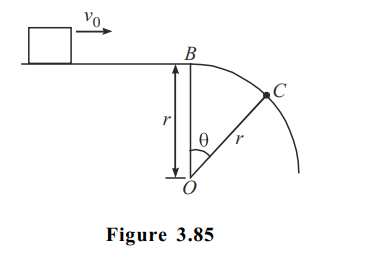Q.
A small block slides with velocity $0.5 \sqrt{g r}$ on the horizontal frictionless surface as shown in the figure- $3.85$. The block leaves the surface at point $C$. The angle $\theta$ in the figure is :
Work, Energy and Power
Report Error
Solution:
From conservation of energy,

Let velocity of block at $C$ is $v$
$\frac{1}{2} m v_{0}^{2}+m g r(1-\cos \theta) =\frac{1}{2} m v^{2} $
$v =\sqrt{v_{0}^{2}+2 g r(1-\cos \theta)}$
when block leaves the surface,
$ N =0 $
$m g \cos \theta =\frac{m v^{2}}{r} $
$ r g \cos \theta =v_{0}^{2}+2 g r(1-\cos \theta) $
$ 3 r g \cos \theta =\frac{r g}{4}+2 r g $
$3 \cos \theta =\frac{9}{4} $
$\cos \theta =\frac{3}{4} $
$ \theta =\cos { }^{-1}\left(\frac{3}{4}\right) $
Questions from Work, Energy and Power
Physics Most Viewed Questions
1. If $E$ and $G$ respectively denote energy and gravitational constant, then $\frac{ E }{ G }$ has the dimensions of:
NEET 2021
Physical World, Units and Measurements
2. The de Broglie wavelength of an electron moving with kinetic energy of $144 \,eV$ is nearly
NEET 2020
Dual Nature of Radiation and Matter
3. A car starts from rest and accelerates at $5\, m / s ^{2}$ At $t=4\, s$, a ball is dropped out of a window by a person sitting in the car. What is the velocity and acceleration of the ball at $t =6\, s$ ? (Take $\left. g =10\, m / s ^{2}\right)$
NEET 2021
Motion in a Straight Line
Latest Updates
- JEE Main 2023 February 25th Shift 1 Morning
- JEE Main 2023 February 25th Shift 2 Evening
- JEE Main 2023 January 31st Shift 1 Morning
- JEE Main 2023 January 31st Shift 2 Evening
- JEE Main 2023 January 30th Shift 1 Morning
- JEE Main 2023 January 30th Shift 2 Evening
- JEE Main 2023 January 25th Shift 1 Morning
- JEE Main 2023 January 25th Shift 2 Evening
- JEE Main 2023 January 24th Shift 1 Morning
- JEE Main 2023 January 24th Shift 2 Evening
- JEE Main 2023 February 1st Shift 1 Morning
- JEE Main 2023 February 1st Shift 2 Evening
- JEE Main 2022 July 25th Shift 1 Morning
- JEE Main 2022 July 25th Shift 2 Evening
- JEE Main 2022 July 26th Shift 1 Morning
- JEE Main 2022 July 28th Shift 1 Morning
- JEE Advanced 2022 Paper 2
- JEE Advanced 2022 Paper 1
- JEE Advanced 2021 Paper 2
- JEE Advanced 2021 Paper 1
- JEE Advanced 2020 Paper 2
- JEE Advanced 2020 Paper 1
- NEET 2022 Physics Answer Key
- NEET 2022 Chemistry Answer Key
- NEET 2022 Botany Biology Answer Key
- NEET 2022 Zoology Biology Answer Key
- NEET Rank Predictor 2023